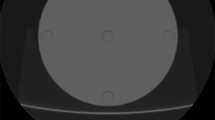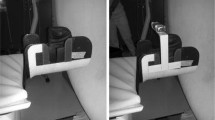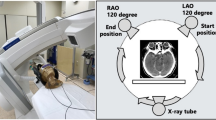Abstract
Background
Exposure of the eye lens to ionizing radiation results in cataract. Several dose optimization techniques to protect the lens are available for computed tomography (CT).
Objective
The radiation dose to the eye lens, volume CT dose index (CTDIvol) and image quality of various methods of dose optimization were evaluated for pediatric head CT: automated tube current modulation (ATCM), automated tube voltage selection (ATVS), organ-based tube current modulation (OBTCM) and bismuth shielding.
Materials and methods
An anthropomorphic phantom of a 5-year-old child was scanned with nine protocols: no dose optimization technique and then adding different dose optimization techniques alone and in combination. Dose to the eye, thyroid and breast were estimated using metal oxide semiconductor field effect transistor (MOSFET) dosimetry. CTDIvol, influence of timing of shield placement, image noise and attenuation values in 13 regions of interest of the head and subjective image quality were compared.
Results
The eye shield significantly reduced the eye lens dose when used alone, to a similar degree as when using all software-based techniques together. When used in combination with software-based techniques, the shield reduced the eye lens dose by up to 45% compared to the no dose optimization technique. Noise was significantly increased by the shield, most pronounced in the anterior portion of the eye.
Conclusion
The combination of ATCM, ATVS, OBTCM and a bismuth shield, with the shield placed after acquiring the localizer image, should be considered to reduce the radiation dose to the eye lens in pediatric head CT.






Similar content being viewed by others
References
Ainsbury EA, Barnard S, Bright S et al (2016) Ionizing radiation induced cataracts: Recent biological and mechanistic developments and perspectives for future research. Mutat Res Rev Mutat Res 770(Pt B):238–261
Poppe E (1957) Experimental investigations on cataract formation following whole-body roentgen irradiation. Acta Radiol 47:138–148
Stewart FA, Akleyev AV, Hauer-Jensen M et al (2012) ICRP publication 118: ICRP statement on tissue reactions and early and late effects of radiation in normal tissues and organs–threshold doses for tissue reactions in a radiation protection context. Ann ICRP 41:1–322
Harbron RW, Ainsbury EA, Barnard SGR et al (2019) Radiation dose to the lens from CT of the head in young people. Clin Radiol 74:816 e819-816 e817
Yabuuchi H, Kamitani T, Sagiyama K et al (2018) Clinical application of radiation dose reduction for head and neck CT. Eur J Radiol 107:209–215
Spearman JV, Schoepf UJ, Rottenkolber M et al (2016) Effect of automated attenuation-based tube voltage selection on radiation dose at CT: an observational study on a global scale. Radiology 279:167–174
Papadakis AE, Damilakis J (2019) Automatic tube current modulation and tube voltage selection in pediatric computed tomography: a phantom study on radiation dose and image quality. Invest Radiol 54:265–272
Santos J, Foley S, Paulo G et al (2015) The impact of pediatric-specific dose modulation curves on radiation dose and image quality in head computed tomography. Pediatr Radiol 45:1814–1822
Papadakis AE, Damilakis J (2020) Evaluation of an organ-based tube current modulation tool in pediatric CT examinations. Eur Radiol 30:5728–5737
Boos J, Kropil P, Klee D et al (2014) Evaluation of the impact of organ-specific dose reduction on image quality in pediatric chest computed tomography. Pediatr Radiol 44:1065–1069
Mehnati P, Malekzadeh R, Sooteh MY (2019) Use of bismuth shield for protection of superficial radiosensitive organs in patients undergoing computed tomography: a literature review and meta-analysis. Radiol Phys Technol 12:6–25
Gargett MA, Briggs AR, Booth JT (2020) Water equivalence of a solid phantom material for radiation dosimetry applications. Phys Imaging Radiat Oncol 14:43–47
Chodick G, Bekiroglu N, Hauptmann M et al (2008) Risk of cataract after exposure to low doses of ionizing radiation: a 20-year prospective cohort study among US radiologic technologists. Am J Epidemiol 168:620–631
Worgul BV, Kundiyev YI, Sergiyenko NM et al (2007) Cataracts among Chernobyl clean-up workers: implications regarding permissible eye exposures. Radiat Res 167:233–243
Tack D, De Maertelaer V, Gevenois PA (2003) Dose reduction in multidetector CT using attenuation-based online tube current modulation. AJR Am J Roentgenol 181:331–334
Kalra MK, Rizzo S, Maher MM et al (2005) Chest CT performed with z-axis modulation: scanning protocol and radiation dose. Radiology 237:303–308
McCollough CH, Bruesewitz MR, Kofler JM Jr (2006) CT dose reduction and dose management tools: overview of available options. Radiographics 26:503–512
Lee CH, Goo JM, Ye HJ et al (2008) Radiation dose modulation techniques in the multidetector CT era: from basics to practice. Radiographics 28:1451–1459
Hoang JK, Yoshizumi TT, Choudhury KR et al (2012) Organ-based dose current modulation and thyroid shields: techniques of radiation dose reduction for neck CT. AJR Am J Roentgenol 198:1132–1138
Franck C, Smeets P, Lapeire L et al (2018) Estimating the patient-specific dose to the thyroid and breasts and overall risk in chest CT when using organ-based tube current modulation. Radiology 288:164–169
Euler A, Szucs-Farkas Z, Falkowski AL et al (2016) Organ-based tube current modulation in a clinical context: Dose reduction may be largely overestimated in breast tissue. Eur Radiol 26:2656–2662
Duan X, Wang J, Christner JA et al (2011) Dose reduction to anterior surfaces with organ-based tube-current modulation: evaluation of performance in a phantom study. AJR Am J Roentgenol 197:689–695
Wang J, Duan X, Christner JA et al (2012) Bismuth shielding, organ-based tube current modulation, and global reduction of tube current for dose reduction to the eye at head CT. Radiology 262:191–198
Lungren MP, Yoshizumi TT, Brady SM et al (2012) Radiation dose estimations to the thorax using organ-based dose modulation. AJR Am J Roentgenol 199:W65-73
Yamauchi-Kawaura C, Yamauchi M, Imai K et al (2013) Image quality and age-specific dose estimation in head and chest CT examinations with organ-based tube-current modulation. Radiat Prot Dosimetry 157:193–205
Lee KH, Lee JM, Moon SK et al (2012) Attenuation-based automatic tube voltage selection and tube current modulation for dose reduction at contrast-enhanced liver CT. Radiology 265:437–447
Hopper KD, King SH, Lobell ME et al (1997) The breast: in-plane x-ray protection during diagnostic thoracic CT–shielding with bismuth radioprotective garments. Radiology 205:853–858
Hopper KD (2002) Orbital, thyroid, and breast superficial radiation shielding for patients undergoing diagnostic CT. Semin Ultrasound CT MR 23:423–427
Sadigh G, Kadom N, Karthik P et al (2018) Noncontrast head CT in children: national variation in radiation dose indices in the United States. AJNR Am J Neuroradiol 39:1400–1405
Colletti PM, Micheli OA, Lee KH (2013) To shield or not to shield: application of bismuth breast shields. AJR Am J Roentgenol 200:503–507
Acknowledgments
We thank Damian Koller and Evelyn Wirth for their excellent technical support.
Author information
Authors and Affiliations
Corresponding author
Ethics declarations
Conflicts of interest
None
Additional information
Publisher's note
Springer Nature remains neutral with regard to jurisdictional claims in published maps and institutional affiliations.
Rights and permissions
About this article
Cite this article
Markart, S., Fischer, T.S., Wildermuth, S. et al. Organ-based tube current modulation and bismuth eye shielding in pediatric head computed tomography. Pediatr Radiol 52, 2584–2594 (2022). https://doi.org/10.1007/s00247-022-05410-x
Received:
Revised:
Accepted:
Published:
Issue Date:
DOI: https://doi.org/10.1007/s00247-022-05410-x




